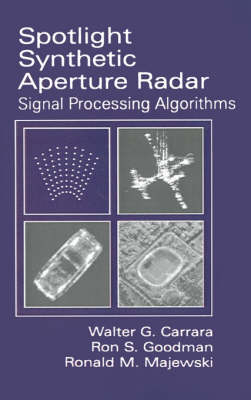
Spotlight Synthetic Aperture Radar
Artech House Publishers (Verlag)
978-0-89006-728-4 (ISBN)
Authored by engineers for engineers, this book is designed to be a practical and easy-to-understand solution sourcebook for real-world high-resolution and spot-light SAR image processing. Widely-used algorithms are presented for both system errors and propagation phenomena as well as numerous formerly-classified image examples. As well as providing the details of digital processor implementation, the text presents the polar format algorithm and two modern algorithms for spot-light image formation processing - the range migration algorithm and the chirp scaling algorithm. Bearing practical needs in mind, the authors have included an entire chapter devoted to SAR system performance including image quality metrics and image quality assessment. Another chapter contains image formation processor design examples for two operational fine-resolution SAR systems. This is a reference for radar engineers, managers, system developers, and for students in high-resolution microwave imaging courses. It includes 662 equations, 265 figures, and 55 tables.
Part 1 Introduction: spotlight SAR; SAR modes; importance of spotlight SAR; early SAR chronology. Part 2 Synthetic aperture radar fundamentals: SAR system overview; imaging considerations; pulse compression and range resolution; synthetic aperture technique for Azimuth resolution; SAR coherence requirements; signal phase equation; inverse SAR (ISAR); SAR sensor parametric design. Part 3 Spotlight SAR and polar format algorithm: scope of processing task; polar format overview; polar data storage as a two-dimensional signal; correction for non-planar motion; polar format algorithm limitations; Taylor series expansion procedures; phase of image pixels; image geometric distortion; image focus error equations; displacements and absolute positioning. Part 4 Digital polar format processing: sampling rate conversion; polyphase filters; polar interpolation; image scale factors; image distortion correction; signal history projections; stabilized scene polar interpolation; subpatch processing and mosaicking. Part 5 Phase errors: classification of phase error; management of phase error; magnitude of phase error; requirements on a practical SAR motion sensor; moving target effects. Part 6 Autofocus techniques: mapdrift; multiple aperture mapdrift; phase difference; phase gradient; prominent point processing; considerations for space-variant refocus. Part 7 Processor design examples: the common UNIX SAR processor; the ground to air imaging radar processor. Part 8 SAR system performance: image quality metrics; system performance budgeting; requirements on system impulse response; requirements on system noise; geometric distortion; secondary image quality metrics; test arrays. Part 9 Spotlight processing applications: spotlight processing of scan and stripmap SAR data; interferometric SAR; forward look SAR; vibrating target detection. Part 10 Range migration algorithm: model; algorithm overview; analytical development; discussion; efficient algorithms for range migration processing. Part 11 Chirp scaling algorithm: non-dechirped signal model; algorithm overview; analytical development; discussion. Part 12 Comparison of image formation algorithms: image formation algorithm models; computational complexity; memory requirements; other considerations.
| Erscheint lt. Verlag | 1.7.1995 |
|---|---|
| Reihe/Serie | Remote sensing library |
| Zusatzinfo | 1, black & white illustrations |
| Verlagsort | Norwood |
| Sprache | englisch |
| Maße | 152 x 229 mm |
| Gewicht | 1006 g |
| Themenwelt | Informatik ► Grafik / Design ► Digitale Bildverarbeitung |
| Mathematik / Informatik ► Informatik ► Theorie / Studium | |
| Mathematik / Informatik ► Mathematik ► Angewandte Mathematik | |
| Naturwissenschaften ► Geowissenschaften ► Geografie / Kartografie | |
| Technik ► Elektrotechnik / Energietechnik | |
| Technik ► Nachrichtentechnik | |
| ISBN-10 | 0-89006-728-7 / 0890067287 |
| ISBN-13 | 978-0-89006-728-4 / 9780890067284 |
| Zustand | Neuware |
| Haben Sie eine Frage zum Produkt? |
aus dem Bereich


